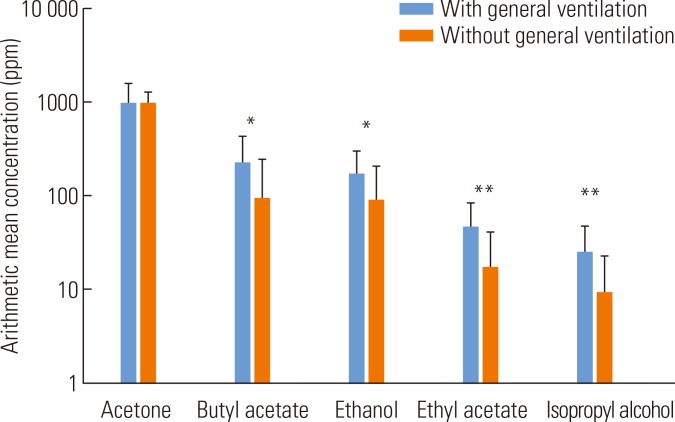Abstract
Objectives
This study aimed to evaluate occupational symptoms and chemical exposures of nail salon technicians.
Methods
Work-related symptoms of nail salon technicians in Daegu City were surveyed using a researcher-administered questionnaire, and responses were compared to those of non-exposed office workers as controls. Personal exposure level of airborne volatile organic compounds was also monitored using passive samplers.
Results
A total of 159 subjects in 120 salons were interviewed. Average work-shift concentrations of 13 chemicals were measured for 50 workers from 30 salons using personal passive samplers. The most frequently reported respiratory or neurologic symptoms by nail shop technicians compared to controls were nose irritation (odds ratio [OR], 54.0; confidence interval [CI], 21.6 to 134.8), followed by headache (OR, 9.3; CI, 4.7 to 18), and throat irritation (OR, 4.3; CI, 2.2 to 8.5). For eyes and skin, 92% of respondents complained eye irritation (OR, 13.1; CI, 5.7 to 30.1). In musculoskeletal symptoms, workers reported pain or discomfort in shoulders (OR, 20.3; CI, 7.7 to 54) and neck (OR, 19.7; CI, 8.9 to 43.6). From personal measurements, the proportion of exceeding the Korean Occupational Exposure Limit was the highest for acetone with 64%, followed by toluene (50%), butyl acetate (46%), and methyl methacrylate (12%). However, the service was being provided without a proper ventilation system in most surveyed shops.
Conclusions
Based on these findings, it is warranted to have appropriate local exhaust ventilation place to ensure adequate health protection of nail shop technicians as well as customers. At the same time, greater policy interests are warranted in nail care business to protect health of both workers and customers.
Keywords: Nail salon, Nail technician, Occupational symptom, Methylmethacrylate
INTRODUCTION
The professional nail care business is growing rapidly since being introduced in Korea from the US in the late 1990s. According to statistical data from the Korea Nail Association, approximately total 50 000 are working in business related to nail art in 2013. It now represents one of the fastest growing industries in Korea [1].
Recently, occupational and environmental health practitioners have raised concerns about potential health problems in nail salon workers due to hazardous chemical ingredients in personal handling products. In particular, methyl methacrylate (MMA) is a well-known irritant to the eyes, skin and respiratory tract, and is also associated with asthma [2].
Under the cosmetic products, including nail products, are exempted from the Material Safety Data Sheets regulation as they are controlled under the Cosmetics Control Act [3].
A nail care technician provides fingernail or toenail care or make-up services, face-to-face and in close proximity with a customer. As a result, they are both exposed to various potential health risks from use of diverse chemicals close to the respiratory system in a narrow indoor environment [4]. However, specific job-related symptoms or exposure assessments have not been sufficiently investigated in Korea. In this context, this study aimed to evaluate the level of complaints of job-related symptoms and exposures to hazardous chemicals of nail salon workers in Daegu metropolitan city and Gyeongbuk areas based on comparison with general office workers as controls.
METHODS
Study Population
This study was conducted at the nail shops in Daegu metropolitan city of Korea. A total of 120 shops were surveyed, including 110 from 141 nail shops registered to the local government (district office) under the business type of nail art and 10 nail shops that provide nail art services to customers despite registered as the cosmetics wholesale business.
Survey of Job-related Characteristics and Subjective Symptoms
A structured questionnaire was developed and used to investigate job characteristics and subjective symptoms of nail shop technicians, including baseline demographics, work environment, job characteristics, and subjective respiratory, neurologic, eyes, skin, and musculoskeletal symptoms. The survey was performed between August and October 2012 to include summer as the season with the highest demand for service. Questionnaires were administered face-to-face, after explaining about the study with a phone call in advance, and getting consent by personally visiting the shop. A total of 159 technicians working at 120 nail shops were responded to the questionnaire.
A control group was selected for comparison of the level of complaining work-related symptoms by nail shop technicians. As the selection criteria for the control, general office workers were chosen who usually work in a sitting position, similar to nail shop technicians, but without handling organic chemicals. The controls were recruited via visiting explanation for volunteers working at office workers and government employees in municipal or county offices geographically close to the study group (nail shop technicians). A total of 105 office workers were included, and the same survey period and symptom questionnaire were used as nail shop technicians.
Evaluation of Airborne Chemical Concentrations
Personal samples for airborne chemical exposure evaluation were collected from 50 workers in 30 nail shops who consented to personal chemical exposure assessment. Among total 50 participants, 30 were out of 159 workers in 120 shops included in the questionnaire survey and 20 were newly participated on the spot without answering questionnaire. Passive sampler (OVM-3520; 3M, St. Paul, MN, USA) was used for sampling, not to interfere with work or movements within a shop, and it was attached within the breathing zone of a worker, and collected air during the entire daily work shift. Samples were mostly collected during weekends when there were many reservations and shops were busy. In addition, the basic characteristics of salons such as average working hours a day, temperature, humidity, volume, location type and mechanical ventilation were investigated.
After collected with a passive sampler, samples were stored below 5℃ until analysis. They were injected with carbon disulfide (CS2) 1.5 mL and desorbed for 30 minutes or more by carefully shaking based on the 3M Sampling and Analysis Guideline [5]. Qualitative/quantitative analysis of extracted organic compounds was performed with the gas chromatography mass spectrometry (Perkin Elmer Turbomass Gold; Perkin Elmer, Warrington, UK). The used OVM-3520 sampler consisted of double-layered adsorption pads and concentrations in the primary and secondary pads were calculated with Formula (1), as per the 3M Analysis Guide.
| (Formula 1) |
Wp, blank-adjusted concentration adsorbed to the primary pad
Ws, blank-adjusted concentration adsorbed to the secondary pad
r, recovery coefficient
A, 1000/sampling rate
t, sampling time (min)
Statistical Analysis
Characteristics between nail salon workers and office workers as controls were compared by student t-test and Pearson chi-square. Results from the health symptom questionnaire survey of nail shop technicians (job coding, 1) and the control group (job coding, 0) were evaluated by the odds ratio (OR) using a multiple logistic regression analysis. ORs were adjusted for the potential confounding effects of age, smoking and alcohol drinking status, exercise, marital status and working career. Descriptive statistical analysis of measurement data was performed and exposure level of data was compared by t-test according to the status of mechanical ventilation in salons. All data analyses were performed using PASW version 18.0 (SPSS Inc., Chicago, IL, USA).
RESULTS
Baseline Characteristics of Nail Shop Technicians in the Survey
Table 1 shows comparison of baseline characteristics of nail shop technicians in the study and office workers as controls. Nail shop technicians were 31.3 years old on average and 61.6% were unmarried, representing a younger and more unmarried population than control (mean age, 34.4 years; unmarried, 38.4%). The working career was shorter for nail shop technicians (mean, 3.7 years) than the control group (mean, 7.4 years) but in terms of mean weekly work hours, nail shop technicians (mean, 56.9 hours) worked 8 hours more on average, than control (mean, 48.9 hours). While routine exercise and alcohol drinking status did not differ greatly, the proportion of smokers was higher among nail shop technicians (20.1%) than control (4.8%).
Table 1.
Comparison of characteristics between nail salon workers and office-based controls
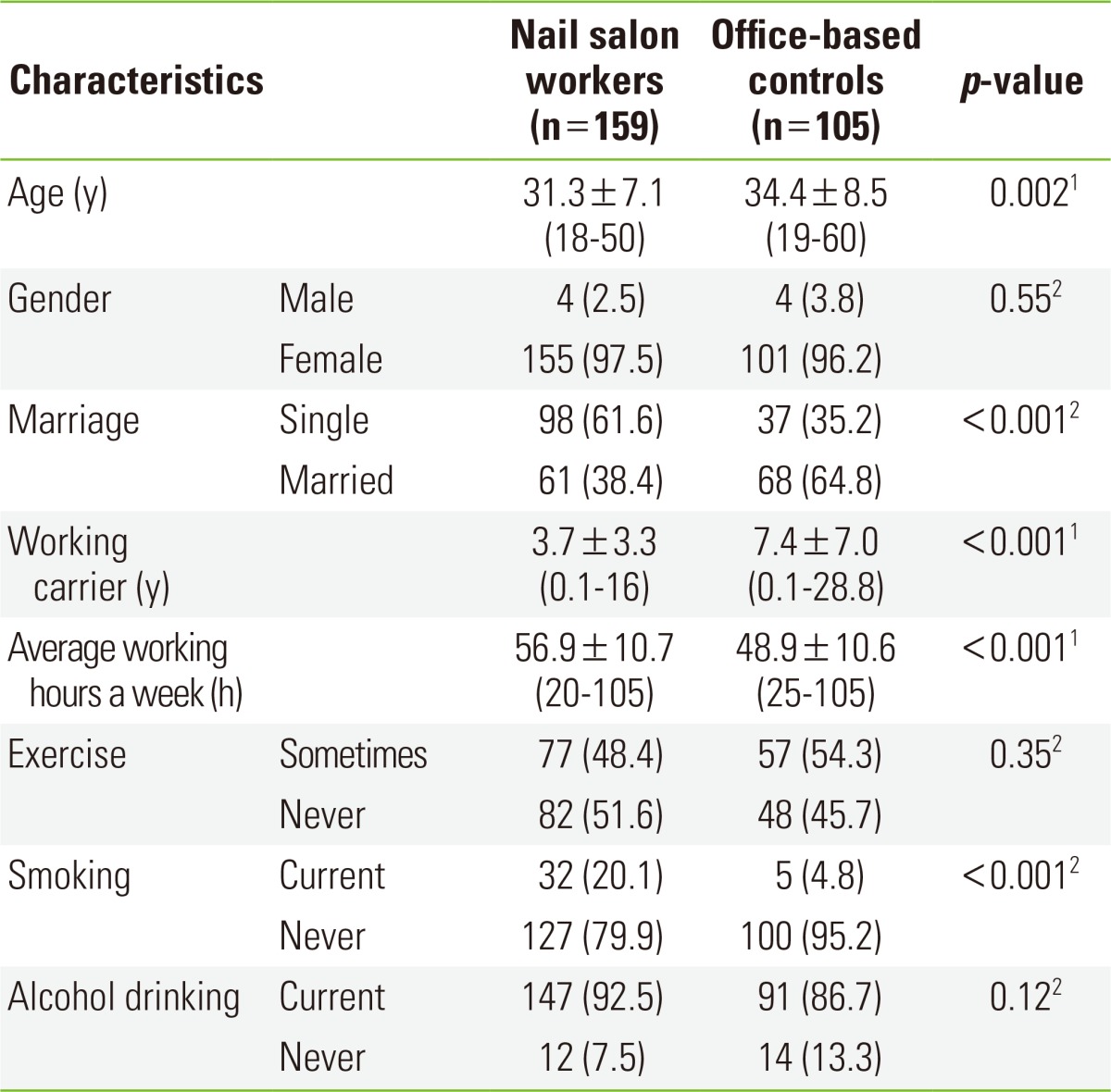
Values are presented as mean±SD (range) or number (%).
1t-test for two independent samples.
2Pearson chi-square (cross-tabulation).
Working Conditions of Nail Shop Technicians
Working conditions of nail shop technicians are summarized in Table 2. During the past month, a nail shop technician served 5 to 9 customers (54.1%) and spent 1 hour for service per customer (45.9%). During the work hours, 79.9% were working without a window or not opening it, if any.
Table 2.
Working conditions of nail salon workers
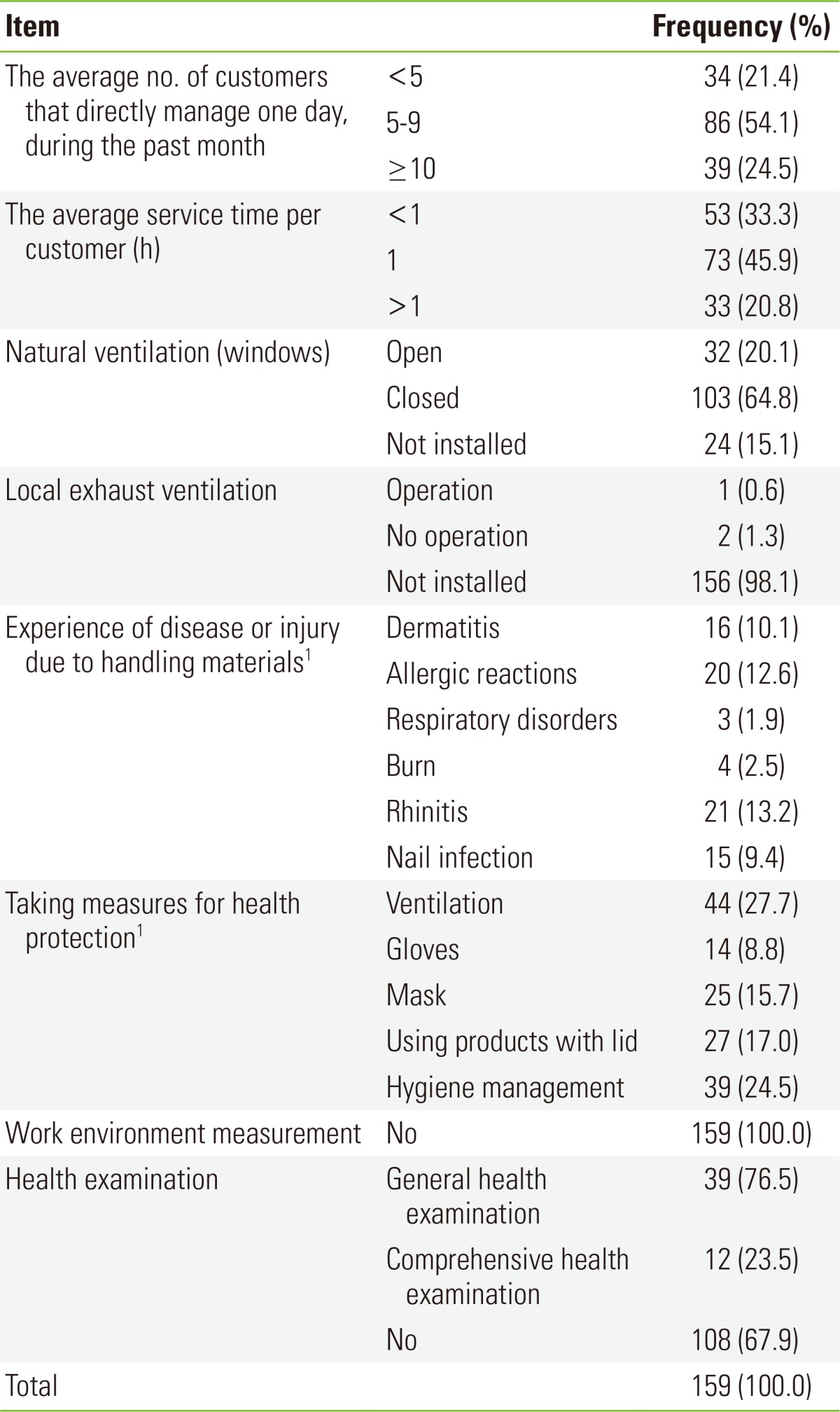
1Multiple choices.
Study subjects were asked whether they experienced any disease or accident involving nail care products; the responses included rhinitis (13.2%), allergy (12.6%), dermatitis (10.1%), and fingernail infection (9.4%); for protection of their own health, thorough personal hygiene control was being practiced by the highest percentage (24.5%). While rhinitis was the most frequently experienced condition, only 15.7% were wearing a mask. No respondent had work environment monitoring before and 67.9% had no health examination.
Comparison of Work-related Symptoms
Table 3 compares work-related symptoms between 159 nail shop technicians and 105 office workers as controls. The most frequently reported respiratory or neurologic symptoms by nail shop technicians were nose irritation (88%), followed by headache (82%), and throat irritation (50%). For eyes and skin, 92% of respondents complained eye irritation. In terms of musculoskeletal symptoms, workers reported pain or discomfort in shoulders (96%) and neck (91%). In control office workers, the most frequently complained symptoms were eye irritation (56%) and headache (37%).
Table 3.
Comparison of work-related symptoms between nail salon workers and office workers
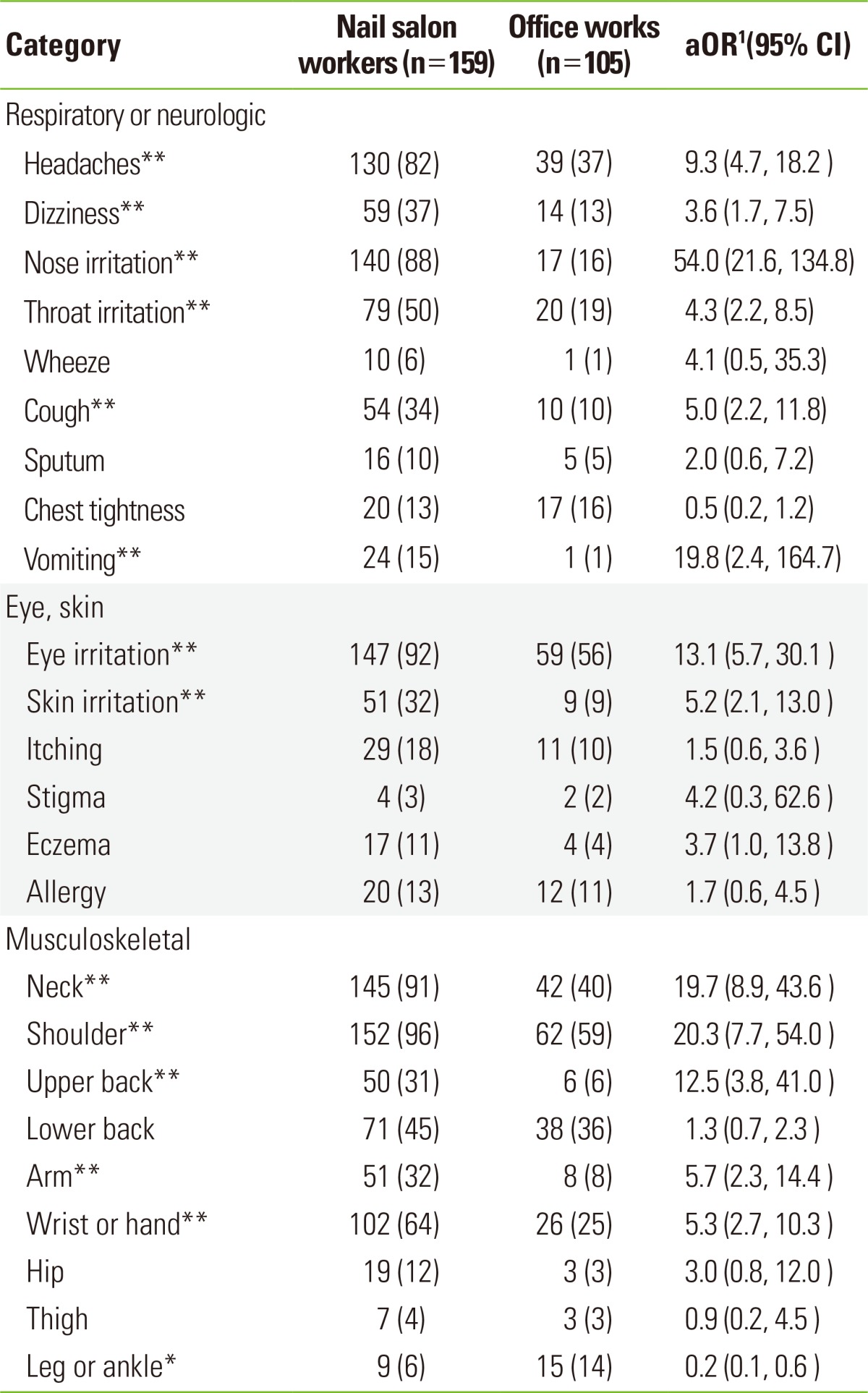
Values are presented as number (%).
aOR, adjusted odds ratio; CI, confidence interval.
1Adjusted for age, marriage, working carrier, average working hours a week, exercise, smoking and alcohol drinking by logistic regression.
*p<0.05, **p<0.01.
The logistic regression analysis found that ORs for subjective respiratory or neurologic symptoms were significantly (p<0.01) higher for nail shop technicians vs. control for headache (OR, 9.3; confidence interval [CI], 4.7 to 18.2), dizziness (OR, 3.6; CI, 1.7 to 7.5), nose irritation (OR, 54; CI, 21.6 to 134.8), throat irritation (OR, 4.3; CI, 2.2 to 8.5), and cough (OR, 5; CI, 2.2 to 11.8). For eyes and skin, the symptom complaint rate of nail shop technicians was higher than control, for eye irritation (OR, 13.1; CI, 5.7 to 30.1), and skin irritation (OR, 5.2; CI, 2.1 to 13). In terms of musculoskeletal pain, nail shop workers had a significantly higher symptom complaint rate (p<0.01) than control for the neck (OR, 19.7; CI, 8.9 to 43.6), shoulders (OR, 20.3; CI, 7.7 to 54), upper back (OR, 12.5; CI, 3.8 to 41), arms (OR, 5.7; CI, 2.3 to 14.4), and wrists or hands (OR, 5.3; CI, 2.7 to 10.3).
Level of Exposure to Organic Chemicals
Fifty nail salon technicians working in 30 different shops voluntarily participated in the exposure assessment study. Basic characteristics of work environment in nail salons at the time of sampling were summarized in Table 4. Personal air sampling was conducted during the full-shift which ranged from 6 to 13 hours a day. Average temperature, relative humidity and volume of salons were 27.4℃, 55.7%, and 70.4 m3, respectively. Most of salons (83.3%) were located along the roadside. In terms of ventilation, general ventilation was being used in 10 salons (33.3%) with ceiling exhaust duct, and 20 salons (66.6%) had no mechanical ventilation system inside the shop.
Table 4.
Basic characteristics of work environment in nail salons measured in this study
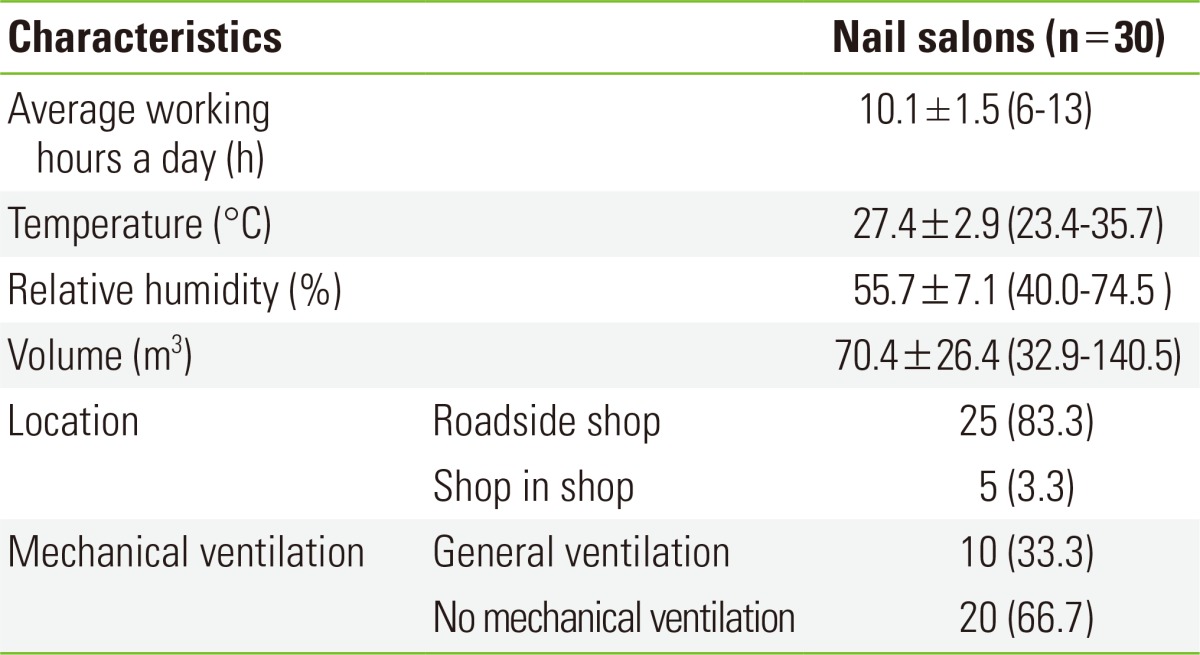
Values are presented as mean±SD (range) or number (%).
A total of 13 substances were detected from 50 personal samples of nail shop technicians, including 3 alcohols (ethanol, isopropyl alcohol, and n-butyl alcohol), 5 esters (ethyl acetate, butyl acetate, vinyl acetate, MMA, and ethyl methacrylate), 2 ketones (acetone and methyl ethyl ketone), and 3 aromatic hydrocarbons (toluene, ethyl benzene, and xylene) (Table 5). Of these, the proportion of exceeding the Korean Occupational Exposure Limit (KOEL) was the highest for acetone (geometric mean [GM], 211.5 ppm; geometric standard deviation [GSD], 13.8) with 64%, followed by toluene (GM, 19.6 ppm; GSD, 12.8; >KOEL, 50%), butyl acetate (GM, 32.7 ppm; GSD, 15.2; >KOEL, 46%), and MMA (GM, 4.2 ppm; GSD, 7.5; >KOEL, 12%).
Table 5.
Airborne concentrations of volatile organic compounds in nail salons
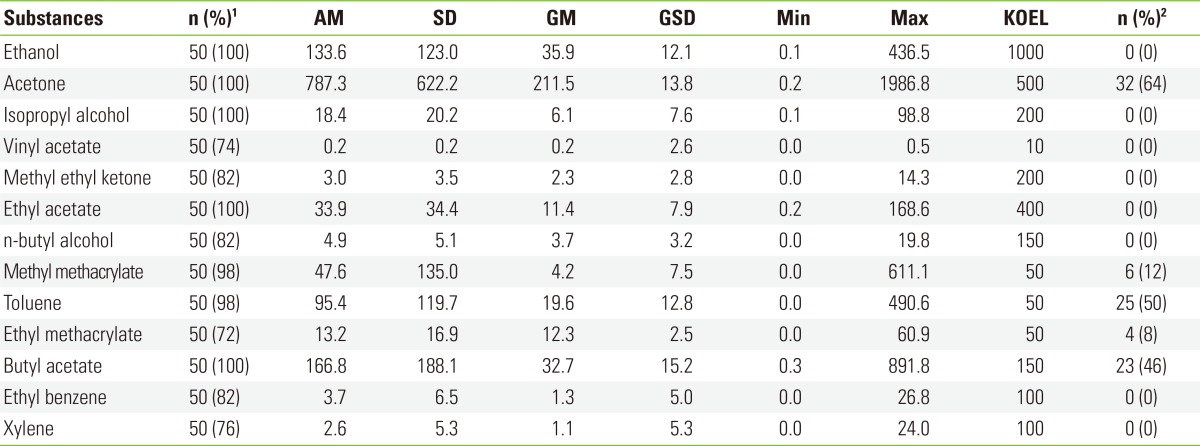
Unit: ppm.
AM, arithmetic mean; SD, standard deviation; GM, geometric mean; GSD, geometric standard deviation; Min, minimum; Max, maximum; KOEL, Korea Occupational Exposure Limit.
1Total no. of samples (detection rate).
2Exposure limits exceeded.
By ventilation status, the measurements of chemicals detected in all samples were consistently higher in shops with general ventilation and the difference was statistically significant for butyl acetate, ethanol, ethyl acetate and isopropyl alcohol (Figure 1).
Figure 1.
Comparison of airborne concentrations of measured solvents detected in all samples by ventilation status. *p<0.05, **p<0.01.
DISCUSSION
From comparison of basic characteristics between nail salon workers and office workers as controls, there were statistically significant differences (p<0.01) in age, marital status, working carrier, average working hours a week and smoking status. The former group was younger, worked longer and included more smokers. After adjusting for these factors, multiple logistic regression analysis was conducted to compare work-related symptoms between groups. From multiple logistic regression analysis, nail salon workers had a higher prevalence of work-related musculoskeletal symptoms such as the neck, shoulders, upper back, arm and wrist or hand in comparison to controls. In particular, over 90% of nail salon workers complained symptoms in the shoulders or neck. Such results were very comparable to those from a UK study [6]. The UK study suggested that risk factors for muscular strain of the neck or shoulders were further magnified when performing visually demanding work while the location of the site of treatment is relatively fixed. In this study, we found that the most of work tables for nail caring services were fixed and 66.7% of nail salon technicians reported that the average service time per customer was longer than one hour (Table 2). In addition, nail salon technicians worked 56.9 hours more compared to office workers per week on average, and this difference was statistically significant (p<0.001). Ergonomic study of similar professions such as podiatry and chiropody [7] suggested a significant link between working practices and postures and elevated rates of musculoskeletal diseases.
This study also demonstrated a higher prevalence of work-related nasal symptoms, headaches and throat irritation relative to non-exposed controls, similar to the UK study. In terms of cough and eye irritation, this study also detected a significant difference that has not been reported in the UK study. This may reflect the difference in the number of respondents as this study (n=159) involved more than twice the number of the UK study (n=71).
Possible association between potential exposure to acrylate and occupational asthma has been indicated in previous investigations [8,9,10,11]. Numerous exposure assessment studies in nail salons have identified acrylates, ketones and aromatic hydrocarbons as potential causes of respiratory disorders of nail salon technicians [4,12,13,14]. The chemicals most frequently detected in airborne samples were butyl acetate, toluene [4,12,13,14], acetone, ethyl acetate, MMA [4,13,14] and ethyl methacrylate [12,13]. In this study, acetone, butyl acetate, ethanol, ethyl acetate and isopropyl alcohol were identified in all of 50 airborne samples. MMA and toluene were also frequently detected in 98% of the samples.
It is worth noticing that measurements in this study were substantially higher than results from prior studies. In particular, a substantial proportion of acetone, toluene, butyl acetate, and MMA samples exceeded the KOEL (64%, 50%, 46%, and 12%, respectively). For MMA, court action was taken by the US Food and Drug Administration during the 1970s for market withdrawal of artificial nail products containing 100% MMA monomer, due to the risk of contact dermatitis and fingernail damage. Although there was no regulation specifically prohibiting use of MMA monomer in cosmetic products, at least 30 states have restricted or banned the use of liquid MMA monomer [15,16]. However, there is no regulation on the use of nail care products containing MMA in Korea.
Such higher levels of exposure to chemicals measured in this study may be attributable to several factors. First, this study utilized full shift-based personal sampling in order to reflect the actual work practice of longer working hours (10.1±1.5 hours) than prior research [4,12,13,14]. Second, all samples were collected on weekends that tended to have more customers than weekdays. Finally, no shop investigated in this study had local exhaust ventilation, and only some of them (33.3%) were running a general ventilation system.
Interestingly, concentrations measured in salons with the general ventilation system were higher than those without the systems, comparable to results from a previous study [16]. It is speculated that general ventilation, in particular, a ceiling exhaust duct may have spread the chemicals throughout a worker's breathing zone, suggesting that local exhaust ventilation may be more efficient in controlling exposure levels for nail salon technicians as well as customers. The UK Health and Safety Executive recommends using a table equipped with a local exhaust ventilation system with a downdraught around 1 meter per second into the table to protect health of nail shop technicians [17]. Nevertheless, such a local exhaust ventilation system was not installed in most cases (98.1%), according to a questionnaire survey of nail salon workers in this study (Table 2).
There were several limitations of this study. First, the severity and actual causes of the reported symptoms cannot be determined from this study design, as no clinical assessment was performed. However, potential exposure to acrylate in the nail salon has previously been associated with occupational asthma and lung function [10,11]. Furthermore, the results of chemical exposure assessment in this study complement well the findings of a study of methacrylate-exposed dental technicians [9], which observed a relationship between daily use of methacrylates and a significantly increased risk of nasal symptoms and work-related cough or phlegm. Second, when ORs were evaluated, we couldn't adjust for the potential confounding effects of psychosocial variables such as job stress, job satisfaction and income. Third, data in this study did not allow analysis of association between chemical measurements and clinical symptoms as only 30 out of 50 workers with available exposure assessment were surveyed for symptoms and their exposure was monitored during weekends. We focused on the worst-case scenario and weekend exposure levels are likely to be higher than the average level including both weekdays and weekends. Therefore, this study may provide insightful results of high level exposure that has not been reported so far in previous research [4,12,13,14].
In summary, the study found that nail shop technicians have a significantly higher complaint rate of work-related subjective symptoms in the respiratory or neurologic system, eyes, skin and musculoskeletal system, compared to office workers, and they are being exposed to airborne acetone, toluene, butyl acetate and MMA above the KOEL. However, the service was being provided without a proper ventilation system in most surveyed shops. Such combination of a small indoor space with poor ventilation may represent health hazards not only to the nail technicians but also to customers, so that there should be an appropriate system, preferably local exhaust ventilation such as a table fan, in place to ensure adequate health protection of nail shop technicians as well as protection of public health. At the same time, greater policy interests are warranted in nail care business to protect health of both nail care workers and customers, for example by establishing a regulatory framework for control of toxic chemicals such as MMA.
ACKNOWLEDGEMENTS
This research was supported by Basic Science Research Program through the National Research Foundation of Korea (NRF) funded by the Ministry of Education, Science and Technology (2013-054650). This research was also supported by the Catholic University of Daegu research fund (20121342).
Footnotes
The authors have no conflicts of interest with the material presented in this paper.
References
- 1.Korean Nail Association. The history of nail art in Korea. 2013. [cited 2013 Dec 15]. Available from: http://www.knanail.or.kr (Korean)
- 2.Cosmetic Ingredient Review Expert Panel. Final report of the safety assessment of methacrylate ester monomers used in nail enhancement products. Int J Toxicol. 2005;24(Suppl 5):53–100. doi: 10.1080/10915810500434209. [DOI] [PubMed] [Google Scholar]
- 3.Ministry of Employment and Labor. Enforcement Decree of the Occupational Safety and Health Act. Article 32-2. Preparations excluded from preparation, keeping, etc., of Material Safety Data Sheet. Presidential decree no. 21653. [cited 2014 Apr 28]. Available from: http://www.moel.go.kr/english/poli/poliLaw_view.jsp?idx=264&tab=7.
- 4.Yang JH, Han DH. Occupational exposure of nail technicians to airborne chemicals and biological monitoring. J Korean Soc Occup Environ Hyg. 2010;20(1):53–62. [Google Scholar]
- 5.3M. 3M technical data bulletin 1028: organic vapor monitor sampling and analysis guide. [cited 2013 Jul 22]. Available from: http://www.cassen.ca/files/sampling-instructions/3m-ovm-sampling.pdf.
- 6.Harris-Roberts J, Bowen J, Sumner J, Stocks-Greaves M, Bradshaw L, Fishwick D, et al. Work-related symptoms in nail salon technicians. Occup Med (Lond) 2011;61(5):335–340. doi: 10.1093/occmed/kqr096. [DOI] [PubMed] [Google Scholar]
- 7.Leah C, Birtles M. Musculoskeletal disorders in podiatry and chiropody professionals: reducing the risk. 2008. [cited 2013 Jul 22]. Available from: http://www.hse.gov.uk/research/rrpdf/rr647.pdf.
- 8.Kreiss K, Esfahani RS, Antao VC, Odencrantz J, Lezotte DC, Hoffman RE. Risk factors for asthma among cosmetology professionals in Colorado. J Occup Environ Med. 2006;48(10):1062–1069. doi: 10.1097/01.jom.0000237348.32645.eb. [DOI] [PubMed] [Google Scholar]
- 9.Jaakkola MS, Leino T, Tammilehto L, Ylöstalo P, Kuosma E, Alanko K. Respiratory effects of exposure to methacrylates among dental assistants. Allergy. 2007;62(6):648–654. doi: 10.1111/j.1398-9995.2007.01379.x. [DOI] [PubMed] [Google Scholar]
- 10.Sauni R, Kauppi P, Alanko K, Henriks-Eckerman ML, Tuppurainen M, Hannu T. Occupational asthma caused by sculptured nails containing methacrylates. Am J Ind Med. 2008;51(12):968–974. doi: 10.1002/ajim.20633. [DOI] [PubMed] [Google Scholar]
- 11.Reutman SR, Rohs AM, Clark JC, Johnson BC, Sammons DL, Toennis CA, et al. A pilot respiratory health assessment of nail technicians: symptoms, lung function, and airway inflammation. Am J Ind Med. 2009;52(11):868–875. doi: 10.1002/ajim.20751. [DOI] [PubMed] [Google Scholar]
- 12.Hiipakka D, Samimi B. Exposure of acrylic fingernail sculptors to organic vapors and methacrylate dusts. Am Ind Hyg Assoc J. 1987;48(3):230–237. doi: 10.1080/15298668791384670. [DOI] [PubMed] [Google Scholar]
- 13.Gjølstad M, Thorud S, Molander P. Occupational exposure to airborne solvents during nail sculpturing. J Environ Monit. 2006;8(5):537–542. doi: 10.1039/b601917j. [DOI] [PubMed] [Google Scholar]
- 14.Quach T, Gunier R, Tran A, Von Behren J, Doan-Billings PA, Nguyen KD, et al. Characterizing workplace exposures in Vietnamese women working in California nail salons. Am J Public Health. 2011;101(Suppl 1):S271–S276. doi: 10.2105/AJPH.2010.300099. [DOI] [PMC free article] [PubMed] [Google Scholar]
- 15.US Environmental Protection Agency. Protecting the health of nail salon workers. 2007. [cited 2013 Jul 22]. Available from: http://www.epa.gov/dfe/pubs/projects/salon/index.htm.
- 16.US Food and Drug Administration. Nail care products: safety and regulatory information. 2013. [cited 2013 Jul 22]. Available from: http://www.fda.gov/Cosmetics/ProductsIngredients/Products/ucm127068.htm.
- 17.Health and Safety Executive. SR13 COSHH essentials for service and retail: nail bars. 2010. [cited 2013 Jul 22]. Available from: http://www.hse.gov.uk/pubns/guidance/sr13.pdf.



